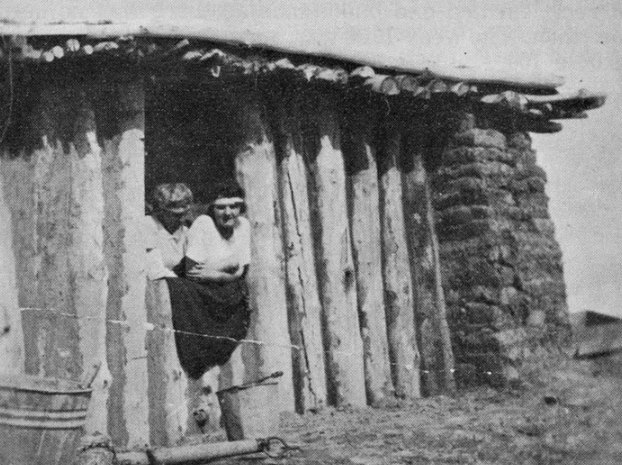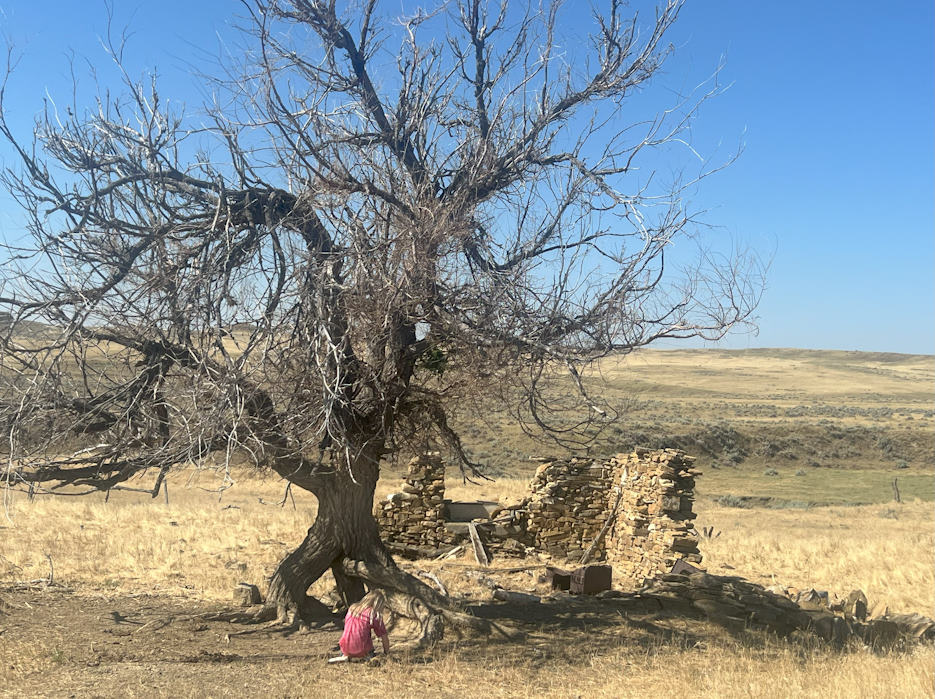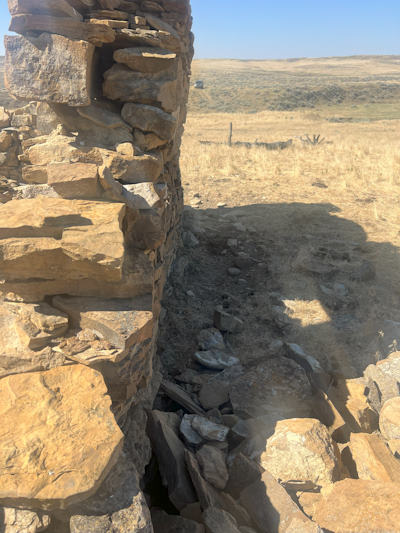The Weipert place, to my mind, is the most outstanding. The house is made of flat rocks gathered from the hill. There are also sheds built into the bank that are fronted by flat rocks. The house is built up on
about a 4 foot bank that has a retaining wall built of flat rock. Behind the house there are huge lilac bushes and trees surround the house. When the Weiperts lived there it must have been beautiful. -- Chris and Loretta Mangen, Echoing Footsteps
 First home on the Weipert homestead - 1918, Echoing Footsteps
First home on the Weipert homestead - 1918, Echoing Footsteps
Mary and Ferdinand Weipert were wed in 1894 in Lansing, Iowa. Several moves and years of homesteading eventually took their growing family to Reeder, North Dakota, where Ferdinand suffered a fatal heart attack. In her 90s, Mary writes in Echoing Footsteps how she and her 7 children survived after moving to Kingsley in 1917:
To support my family, I did laundry at home, and the community was kind to us... A good friend, Mr. Nick Lenertz, suggested I take up a homestead in Montana. He had a son, Vincent, and a daughter, Mamie, who had filed at Kingsley. My eldest son, George, and I filed there as well. Margaret went to stay with an aunt in Lansing, Iowa, to attend school. The rest of us set off for Miles City with a freight car full of furniture, machinery, and five horses. We stored some furniture in Miles City and prepared for our journey to the Kingsley homestead. George left for the Army at Fort Lewis, Washington, and we all bid him farewell before heading to Kingsley. The weather was stormy, making the trip take three days. Since Vincent and Mamie's land was adjacent to ours, we initially made our home in their shack while we dug a well by hand, plowed some land, and planted corn and beans. After the crops were sown, we began constructing our home, which was a combination of a dug-out and a sod house, with stockade logs forming the front. The roof was made of logs and poles covered with dirt, which leaked during heavy rains but kept us warm. We all worked diligently. In 1918, flour was priced at $17.00 for 100 lbs. with subsidies. During the flu epidemic of 1918, Mary and her friend Miss Lenertz, along with Ed DuRussel, worked at the Wibaux hospital. Mary married Ed DuRussel in 1919, and they lived with us for several years, assisting in building an addition to our rock house, farming, and constructing fences, as there was no herd law at that time. The year 1919 was particularly dry, and potatoes cost $9.00 for 100 lbs.
 Modern day remnants of the Weipert homestead, currently owned by Mike Leffingwell.
Modern day remnants of the Weipert homestead, currently owned by Mike Leffingwell.
....In 1919, after the spring crop was harvested, my son, Herman, and my son-in-law, Ed, were employed in Broadus. They excavated the basement for the first Powder River County Bank using a team and a scraper.
During the school term of 1920, Mr. Manker and Donald joined us and transported the school children along with the teacher to the Lewis School. The students included Donald Manker, Magdaline and Isabel Weipert, Mike and Nick Severovic, with Mae Severovic as the teacher. The following year, a new schoolhouse was constructed on the Ambuel property, located approximately four miles from home. George sustained a back injury while serving in the Army and spent more than a year in a hospital in Salt Lake City. He was discharged and came back home in the autumn of 1919, and it was wonderful to have him back with us.
 Surviving wall from Weipert's homestead.
Surviving wall from Weipert's homestead.
George established his homestead and assisted in producing feed for the cattle I purchased. He acquired the George Craft property for grazing. In 1921, ... together with my son George and the three girls—Margaret, Magdaline, and Isabel—we cultivated feed and cattle, milked cows, and sold cream. We maintained productive gardens and grew strawberries. George spent a couple of winters in Bozeman attending Agricultural School, while the girls and I managed the livestock. He returned in the spring to help with the farming tasks.
We experienced both challenging and fruitful years. The year 1934 was particularly dry, resulting in a lack of feed, which forced us to sell most of our cattle. The only feed we had was what remained from the previous year. In 1940, we purchased the Al Waltz property, renovated the house, and updated it. We planted fruit and shade trees, and cultivated a vegetable garden along with strawberries for sale. George bought calves to raise. We enjoyed numerous joyful gatherings, club meetings, birthday celebrations, and Good-Neighbor club events.